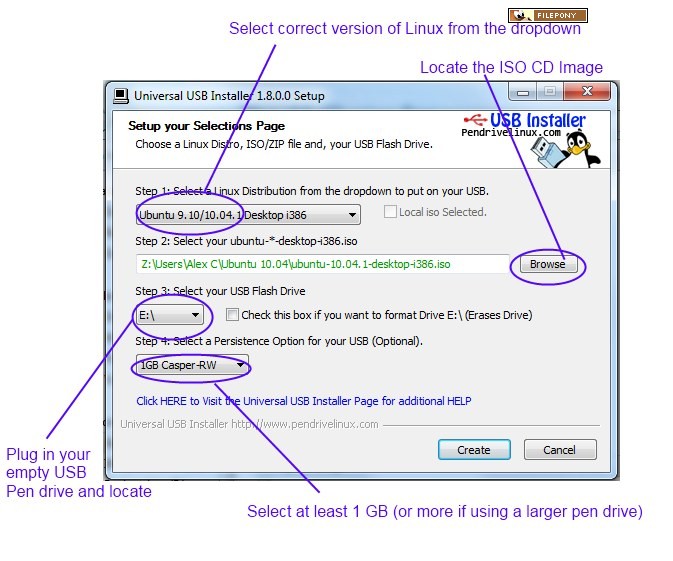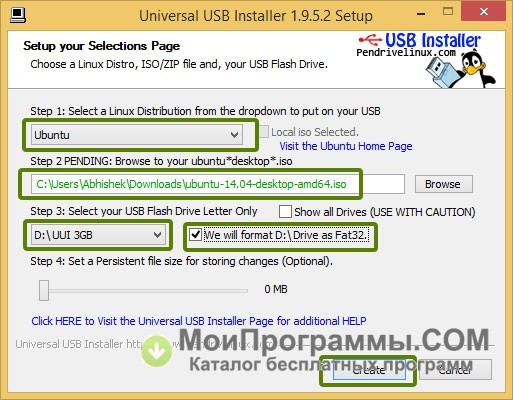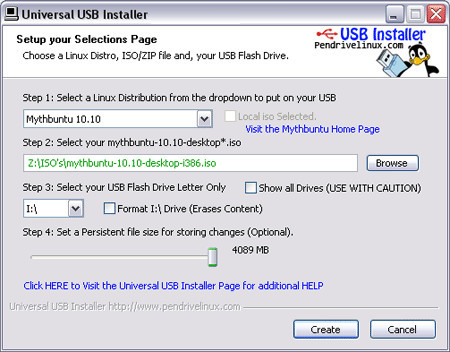
- UNIVERSAL USB INSTALLER FREENAS INSTALL
- UNIVERSAL USB INSTALLER FREENAS SOFTWARE
- UNIVERSAL USB INSTALLER FREENAS ISO
- UNIVERSAL USB INSTALLER FREENAS TORRENT
- UNIVERSAL USB INSTALLER FREENAS WINDOWS
In your side, if you don’t have a valid DNS server you can skip this step.

To configure DNS choose number 6 and press enter, then we have to enter the DNS information such as domain, IP address of DNS server and Press Enter.Ĭonfiguring the DNS settings before IP Address will resolve the name from DNS. Note: First let me configure the DNS, I have a valid name resolver at my end, so let me configure my DNS settings.ġ0. Here we can see that, we’ve got a dynamic IP address as 192.168.0.10 now we have to configure our static ip. After FreeNAS setup completed, we can get the console setup menu to add the DNS IP Address to access the FreeNAS web dashboard.īy default at first it will assign a dynamic IP address and we have to configure it manually. On the next screen, choose the 3rd option to reboot the machine and remove the setup Disk. Choose OK to reboot the machine and remove the installation Disk. After few minutes it will take us to the end of the installation process. Warning: Please take a backup of selected drive before starting FreeNAS setup. After selecting the drive, on the next screen you will warned for data loss, If you have any important data in that selected drive, please take a backup before installing FreeNAS on the drive.Īfter pressing ‘ Yes‘ all the data in that drive will be destroyed during installation. We have total 9 drives, so here I’m using first 5 GB ada0 drive for my FreeNAS installation and other 8 Drives are used for Storage (will be discussed in next part of this series).Ĭhoose ada0 drive from the listed drives and press Enter to continue. In this step, we need to choose where FreeNAS should be installed.
UNIVERSAL USB INSTALLER FREENAS INSTALL
This will install the FreeNAS if its not existed. For installing FreeNAS, we have to choose Install/ Upgrade. After booting the system with FreeNAS image, by default it will start the installation, if not we have to press enter to continue the installation.
UNIVERSAL USB INSTALLER FREENAS ISO
After you download FreeNAS ISO image from the links above, if you’ve a CD/DVD drive, burn that ISO image to a disc and then boot it, or if you’re using USB Image you can directly boot it.ģ. As every Operating system FreeNAS too have the similar steps for installation and it won’t take more than 2 minutes to Install.Ģ. Now its time to install and configure FreeNAS. I’ve included download links for CD/DVD and USB bootable images of FreeNAS, so select and download images as per your requirements. version 9.2.1.8) from the FreeNAS download page, or you can use the following links to download image for your system architecture. To set up a FreeNAS operating system, you will need to download latest stable installation ISO Image (i.e.
UNIVERSAL USB INSTALLER FREENAS TORRENT
In this FreeNAS 4-article series, we will cover the installation and configuration of FreeNAS with storage and in later articles will cover setting up a video streaming & torrent server.
UNIVERSAL USB INSTALLER FREENAS WINDOWS


Home users can build FreeNAS storage to store there videos, files and stream from FreeNAS to every network devices or to smart TVs etc.

FreeNAS Installation and ConfigurationįreeNAS supports Linux, Windows and OS X and numerous virtualization hosts such as VMware and XenServer using protocols such as CIFS (SAMBA), NFS, iSCSI, FTP, rsync etc.
UNIVERSAL USB INSTALLER FREENAS SOFTWARE
Using FreeNAS software you can easily build your own centralized and easily accessible data storage at home and same can be managed via a dedicated web interface originally written in PHP language, later re-written using Python/Django language from scratch. FreeNAS operating system is totally based on BSD and can be installed on virtual machines or in physical machines to share data storage via a computer network. FreeNAS is an open source network-attached storage (NAS) operating system based on BSD and the ZFS filesystem with integrated RAID support.


 0 kommentar(er)
0 kommentar(er)
